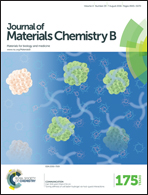An eco-friendly ultra-high performance ionic artificial muscle based on poly(2-acrylamido-2-methyl-1-propanesulfonic acid) and carboxylated bacterial cellulose†
Abstract
Eco-friendly high-performance ionic artificial muscles have recently attracted enormous interest because of their applications in human friendly electronics including flexible haptic devices, wearable electronics, disposal or implantable biomedical devices, and biomimetic robots. Here, we report an eco-friendly ionic polymer actuator based on poly(2-acrylamido-2-methyl-1-propanesulfonic acid) (PAMPS), carboxylated bacterial cellulose (CBC), and an ionic liquid (IL) as a plasticizer, demonstrating ultra-high electromechanical deformation, quick response, and excellent durability. The proposed CBC–IL–PAMPS composite membrane exhibits an increased ionic conductivity, tensile strength, and specific capacitance of up to 32.5%, 44.9%, and 160%, respectively, thereby resulting in 4.5 times larger bending deformation than that of the CBC–IL actuator, all of which are due to the cross-linking and ionic interactions among the sulfonate functional groups of PAMPS, carboxylate functional groups of CBC, and the IL ([EMIM][BF4]). The developed electro-chemo-mechanical CBC–IL–PAMPS actuator is a promising candidate for human friendly electronics such as artificial muscles, wearable devices, biomedical devices, and biomimetic robots due to its high actuation performance, low operating voltage, and fast response as well as durable operation.


 Please wait while we load your content...
Please wait while we load your content...